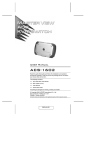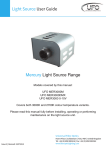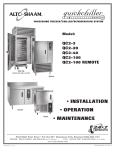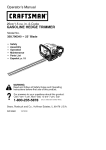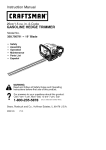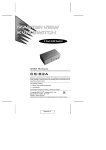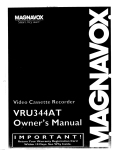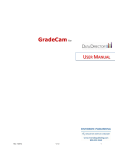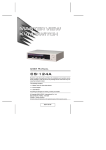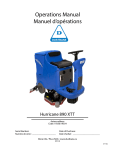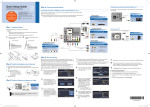Download ATEN CS-914 User manual
Transcript
User Manual CS-914 Read this guide thoroughly and follow the installation and operation procedures carefully in order to prevent any damage to the units and/or any devices that connect to them. This package contains: M 1 4 Port Mini KVM Switch M 1 User Manual If anything is damaged or missing, contact your dealer. © Copyright 2000 ATEN International Co., Ltd. Manual Part No. PAPE-1167-100 Printed in Taiwan 11/1999 All brand names and trademarks are the registered property of their respective owners. 2001 - 02 -07 Overview The Master View CS-914 Mini KVM Switch is a control unit that allows access to four computer systems from a single console (keyboard, mouse, and monitor). Before the development of the Master View, the only way to control multiple computer configurations from a single console was through a complex and costly network system. Now, with the Master View CS-914, you can easily access up to four computers in a cost effective manner. The Master View CS-914 provides two convenient methods to access the computers connected to the system: using the push button Port Selection Switch located on the unit’s right panel; and entering Hot Key combinations from the keyboard. Setup is fast and easy; plugging cables into their appropriate ports is all that is entailed. There is no software to configure, no installation routines, and no incompatibility problems. Since the Master View CS-914 intercepts keyboard input directly, it works on any hardware platform and with all operating systems. There is no better way to save time and money than with a Master View CS-914 installation. By allowing a single console to manage all of the attached computers, the CS-914 eliminates the expense of purchasing a separate keyboard, monitor, and mouse for each system. Additionally, it saves all the extra space they would take up, and eliminates the inconvenience and wasted effort involved in constantly having to move from one computer to the other. -1- 2001 - 02 -07 Features M Supports Microsoft IntelliMouse and the scrolling wheel on most ’wheel’ mice M Keyboard and mouse emulation for error free computer booting M Caps Lock, Num Lock, and Scroll Lock states are saved and restored when switching M Up to 1920 x 1440 resolution M Easy to install - no software required - standard cables to connect to the computers is all it takes M Easy to operate - computer selection via push button switch or hotkeys M Auto Scan function to monitor computer operation M Compatible with all operating platforms M LED display for easy status monitoring M Saves time, space, power, and equipment costs M Non-powered M Supports DDC2 (Display Data Channel) M Hot pluggable -2- 2001 - 02 -07 Hardware Requirements Console M One VGA, SVGA, or Multisync monitor capable of the highest resolution that you will be using on any computer in the installation M One PS/2 Mouse M One PS/2 Style Keyboard, or AT Style Keyboard plus a keyboard adapter Computers The following equipment must be installed on each computer that is to be connected to the system: M A VGA, SVGA or Multisync card. M A 6-pin mini-DIN (PS/2 style) mouse port. M Either a 6-pin mini-DIN (PS/2 Style) keyboard port with +5V DC on pin 4 and Ground on pin 3, or a 5-pin DIN (AT Style) keyboard port with +5V DC on pin 5 and ground on pin 4.* * See the note under Cables in the next section. Cables Although it is possible to use standard KVM cables to connect the computers to the Master View CS-914, for optimum signal integrity and to simplify the layout, we strongly recommend that you use high quality CS Custom Cables (Part Number 2L-1001P/C). Note: The keyboard and mouse cables have PS/2 style connectors at each end: M If your computer uses a standard AT style keyboard socket, you will need a PS/2-to-AT keyboard adapter (purchased separately), in order to plug the cable into the computer’s keyboard port. M The Master View CS-914 only supports PS/2 style mice - it does not support serial mice. -3- 2001 - 02 -07 Introduction Top View LEDs LEDs LEDs: Each CPU Port has a corresponding LED. The LED lights when its port is selected. Depending on the port’s status, the LED may flash according to a specific pattern (see the table in the Appendix for details). -4- 2001 - 02 -07 Right Side View Port Selection Switch Port Selection Switch: Pressing this push button switch cycles through the four CPU ports (A B C D A, etc.), to select the active port. Front / Rear View 1 2 1 3 2 3 Connectors: The front and rear panels each contain two sets of connectors for the CPU Ports. The left panel contains one set of connectors for the console. Each connector is indicated by an appropriate icon. 1. Video Connector 2. PS/2 Style Keyboard Connector 3. PS/2 Style Mouse Connector -7- 2001 - 02 -07 Installation Before you begin, make sure that power to all the devices you will be connecting up (Master View CS-914, the monitor, and the connected computers) have been turned off. 1. Plug the monitor, keyboard, and mouse into the Console port connectors (located on the left side panel), of the Master View CS-914 unit. PS/2 MOUSE MONITOR PS/2 KEYBOARD -8- 2001 - 02 -07 2. Use the KVM cables (as described in the Hardware Requirements section), to connect the monitor, keyboard and mouse ports of the computers to the CPU Ports (on the front and rear panels), as shown in the diagram below. Note: If your computers use AT style connectors for the keyboard ports, refer back to the note in the Cables Section on p.3. PS/2 Typ e Keyboard Cable PS/2 Type Mouse Cable Monitor Cable 3. Turn on the power to the monitor and the connected computers. Note: The Power On default is to link to Port A. If the computer attached to Port A is inactive, the monitor will be blank so it may appear as if the unit is not functioning. This is not the case. Simply use one of the Port Selection methods (described below), to switch to an active computer on one of the other ports (B, C, or D). -9- 2001 - 02 -07 Operation Controlling the computers in your Master View installation from a single console could not be easier. Two port selection methods that provide instant access to the computers are available: Manual Port Selection With Manual Port Selection, you simply press the Port Selection button on the Master View’s right panel to cycle among the computers (A → B → C → D → A, etc.). The Selected LED on the top panel lights to indicate which port is active. Hot Key Port Selection Hot Key navigation allows you to select the active computer directly from the keyboard, instead of having to manually select it by pressing the Port Selection button. The Master View CS-914 provides several Hot Key navigation features. These are: M Selecting the Active Port M Auto Scan Mode M Last/Next Mode Note: All Hot Key operations begin by pressing andreleasing the Alt+Ctrl+Shift combination. The combination must all be on the same side. i.e.: Left Alt + Left Ctrl + Left Shift, or Right Alt + Right Ctrl + Right Shift - 10 - 2001 - 02 -07 Selecting the Active Port: Each CPU port is assigned an alpha ID (CPU A, CPU B, CPU C, CPU D). A Port ID Number is associated with each letter (see table, below).You access the computer attached to a port by specifying the Port ID as part of the Hot Key combination as follows: 1. Press and release Alt+Ctrl+Shift 2. Key in the appropriate Port ID Number (1, 2, 3, or 4) 3. Press [Enter] The Port ID numbers that correspond to the port letters are as follows: Port Letter Port ID Number A 1 B 2 D 3 E 4 Auto Scan Mode: The Auto Scan feature automatically switches among the four computers at regular intervals so that you can monitor their activity without having to take the trouble of switching yourself. To invoke Auto Scan Mode, key in the following Hot Key combination: 1. Press and release Alt+Ctrl+Shift 2. Press and release 0 (zero) 3. Press [Enter] Once scanning begins, it continues until you press the [Spacebar] to exit Auto Scan Mode. The port that was currently active at the time scanning stopped remains active. Note: While Auto Scan Mode is in effect, none of the other keyboard keys will function. You must exit Auto Scan Mode by pressing the [Spacebar] in order to use the console for anything else. - 11 - 2001 - 02 -07 Appendix Selected LED Display: Activity Meaning Off Port is not selected. On (Steady) Port is connected to an active computer. Flashing (On and Off equal) Port is connected to an active computer and is being accessed in Auto Scan mode. Flashing (On long; Off short) Port is connected to an active computer and is being accessed in Last/Next mode. Specifications Function Specification Computer Connections 4 Port Selection Push Buttin Switch / Hot Keys LEDs 4 Selected Connectors Keyboard 1 x 6 pin mini-DIN female (PS/2 style) - Console 4 x 6 pin mini-DIN female (PS/2 style) - CPU Ports Mouse 1 x 6 pin mini-DIN female (PS/2 style) - Console 4 x 6 pin mini-DIN female (PS/2 style) - CPU Ports Video 1 x HDB-15 female (std. VGA/SVGA) - Console 4 x HDB-15 male (std. VGA/SVGA) - CPU Ports Operating Temperature 5 ~ 40oC Storage Temperature -20 ~ 60oC Humidity 0 ~ 80% RH Noncondensing Enclosure Plastic Weight 250 g Dimensions (L x W x H) 170 x 87 x 28.5 mm - 12 - 2001 - 02 -07 Trouble Shooting Note: If you are experiencing problems, first make sure that there are no problems with the cables, and that they are all properly connected. Symptom Keyboard Not Repsonding Pressing Hot Keys gets no response. Possible Cause Action Losse Cables Check all keyboard cable connections to make sure they are completely seated in their sockets. Keyboard needs to be reset Unplug the keyboard from the Console Keyboard Port, then plug it back in. Master View needs to be reset Turn off the computers; wait five seconds; then turn the computers back on. Master View is in Auto Scan Mode or Last/Next Mode Press the [Spacebar] to exit Auto Scan or Last/Next Mode. Selected port connects to a powered Off computer. Change the port manually by pressing the appropriate Port Selection switch. Resend the Hot Key command selecting a port that has a Powered On computer attached. Hot Key sequence input incorrectly. Resend the Hot Key command press and release each key in the sequence individually: [Ctrl] then [Shift] then [Alt] then the Port ID number, then [Enter]. Master View is in Auto Scan Mode or Last/Next Mode Press the [Spacebar] to exit Auto Scan or Last/Next Mode. - 13 - 2001 - 02 -07 Symptom Mouse Not Detected, or Does Not Respond Correctly.** Possible Cause Action Loose cables Check all mouse cable connections to make sure they are completely seated in their sockets Use of Mouse Port Adapters. This unit is designed to only work with PS/2 mice and computers with PS/2 type mouse ports. PS/2 mouse signals and serial mouse signals are different - adapters will not convert the signals - therefore, the computer must be equipped with a PS/2 type mouse port. Serial mouse ports with adapters cannot be used. Mouse needs to be reset. Unplug the mouse from the Console Keyboard Port, then plug it back in. Master View needs to be reset. Turn off the computers; wait five seconds; then turn the computers back on. Mouse set to Serial Mode. Some mice can be set to act as either a PS/2 or serial mouse. Make sure the mouse is set to PS/2 mode. Incorret Mouse Driver Check your Device Manager to be sure that the correct driver for your mouse (obtained from the manufacturer, or supplied by the operating system), has been installed. Because of the wide variety of mouse driver standards for the modern series of mice (the ones with the extra buttons and wheels), the CS-914 only supports all the extra features of the Microsoft Intellimouse. It supports the scrollwheel function of most other mice. - 14 - 2001 - 02 -07 Symptom Video Problems Possible Cause Action Resolution and/or Bandwidth set too high. The Master View CS-914 supports VGA, SVGA, Multisync, and XGA (interlaced), with resolutions of up to 1280x1024 @ 80 Hz. The maximum bandwidth is 150 MHz. Cable quality not good enough. We strongly recommend that you use high quality cables. Using high quality cables should eliminate possible video problems. * The Master View CS-914 is designed to work with AT and PS/2 keyboards. Older XT (84 key) and some older AT keyboards ( those with the function keys on the side), will not work. ** Some Notebook computers, notably the IBM Thinkpad and Toshiba Tecra, have trouble working with the Master View CS-914 when their mouse and keyboard ports are used simultaneously. To avoid this problem, only connect the mouse port or the keyboard port to the Master View unit. If you connect the mouse port, you will need to use the notebook’s keyboard when the notebook becomes the active computer. - 15 - 2001 - 02 -07 Radio & TV Interference Statement WARNING!!! This equipment generates, uses and can radiate radio frequency energy and, if not installed and used in accordance with the instruction manual, may cause interference to radio communications. This equipment has been tested and found to comply with the limits for a Class B computing device pursuant to Subpart J of Part 15 of FCC Rules, which are designed to provide reasonable protection against such interference when operated in a commercial environment. Operation of this equipment in a residential area is likely to cause interference, in which case the user at his own expense will be required to take whatever measures may be required to correct the interference. Limited Warranty IN NO EVENT SHALL THE DIRECT VENDOR’S LIABILITY EXCEED THE PRICE PAID FOR THE PRODUCT FROM THE DIRECT, INDIRECT, S P E C I A L , I N C I D E N T A L O R C O N S E Q U EN T I AL D AM AG ES RESULTING FROM THE USE OF THE PRODUCT, DISK OR ITS DOCUMENTATION. The direct vendor makes no warranty or representation, expressed, implied, or statutory with respect to the contents or use of this documentation, and specially disclaims its quality, performance, merchantability, or fitness for any particular purpose. The direct vendor also reserves the right to revise or update the device or documentation without obligation to notify any individual or entity of such revisions, or update. For further inquires please contact your direct vendor. 2001 - 02 -07















